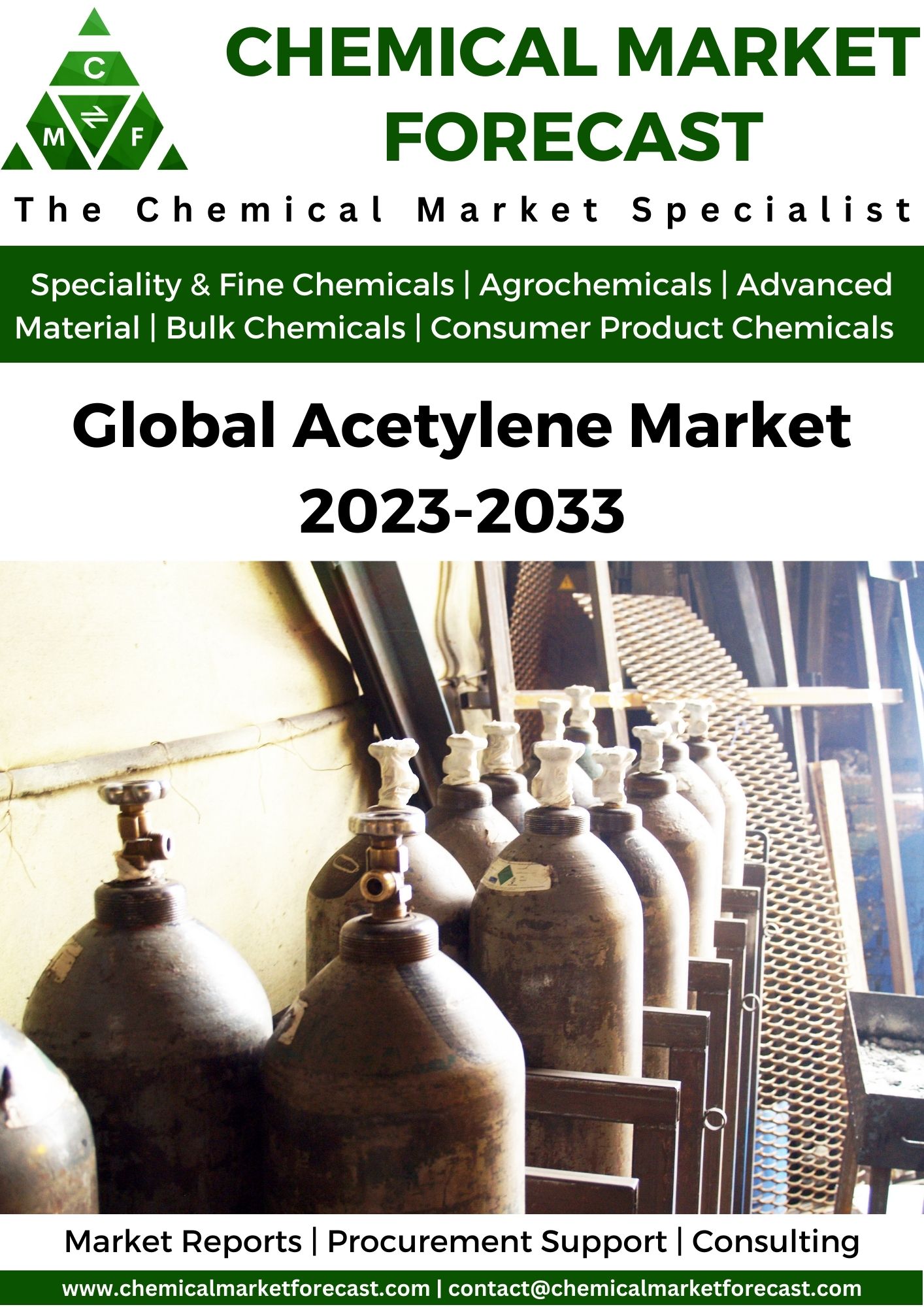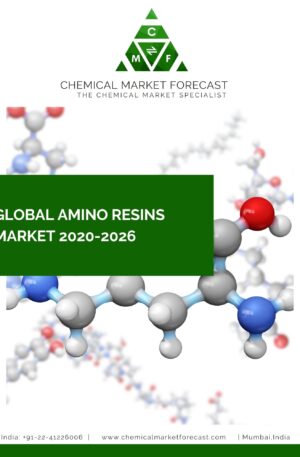Global Acetylene Market
The market for acetylene is driven by its various industrial applications, particularly in the welding and cutting sector. The growing demand for acetylene as a fuel for welding and cutting applications, as well as its use as a chemical intermediate in the production of other chemicals, is expected to drive the growth of the market.
Acetylene is also used in the production of PVC (polyvinyl chloride), which is a widely used plastic material, and in the manufacture of chemicals such as acetic anhydride, acrylates, and other derivatives.
Acetylene is a colorless, flammable gas with a pungent odor, chemical formula C2H2. Acetylene is highly reactive and flammable, and it must be handled and stored with caution. In addition to its use in welding and cutting, acetylene has a wide range of other industrial and laboratory applications, including as a fuel for combustion engines, as a source of heat, and as a reagent in chemical synthesis. By the reaction of calcium carbide with water, which produces calcium hydroxide and acetylene gas. The gas can then be collected, compressed, and stored in cylinders for use in various applications.
The discovery of acetylene can be traced back to the early 19th century, when French chemist Edmund Davy first isolated the gas in 1836. However, it wasn’t until the late 19th and early 20th centuries that acetylene began to be used as a fuel gas. In the 1890s, French engineer and inventor Henri Moissan discovered that acetylene could be used as a fuel for the carbide lamp, a portable lighting device that was commonly used in mines and caves at the time. This sparked interest in using acetylene as a fuel source, leading to the development of larger-scale production methods and storage systems. In the early 20th century, acetylene became increasingly popular as a fuel for welding and cutting operations, due to its high heat output and versatility. This led to the growth of the industrial gas industry, with companies such as Linde and Air Liquide establishing themselves as major suppliers of acetylene and other industrial gases. Today, acetylene continues to be widely used as a fuel gas in welding and cutting, as well as for heating and other industrial applications. With advances in technology and improved production methods, the use of acetylene has become even more widespread and essential to many industries.
The Asia-Pacific region is a major market for acetylene, with China being the largest producer and consumer of acetylene. Other key markets for acetylene include North America, Europe, and the Middle East.
Factors that can impact the market for acetylene include the availability and cost of raw materials, competition from alternative fuels and chemicals, and government regulations on the use of acetylene. The volatility in the prices of raw materials and the fluctuation in demand for acetylene can also affect the market.
There are several key suppliers of acetylene gas, including major industrial gas companies such as: Air Liquide, Praxair, Linde, Air Products and Chemicals, Inc., Taiyo Nippon Sanso Corporation These companies provide acetylene to various industries for use as a fuel gas, raw material for chemical synthesis, and other applications. They have a wide distribution network and offer a range of products and services, including cylinder and bulk supply options, as well as technical support and safety training. In addition to these major players, there may be smaller local suppliers of acetylene in specific regions, depending on the demand and industry needs in those areas.
TABLE OF CONTENT
Global Acetylene Market Report
1 Market Introduction of Global Acetylene Market Report
2 Market Segmentation of Acetylene Market Report
2.1 Acetylene Market Segmentation By Region
2.2 Acetylene Market Segmentation By Type
2.3 Acetylene Market Segmentation By Crop Type
3 Cost Structure of Acetylene Market Report
4 Country Analysis of Acetylene Market Report
4.1 China
4.1.1 Acetylene Market Forecast & Size in China
4.1.2 Acetylene Market Trends & Analysis in China
4.1.3 Key Acetylene companies in China
4.1.4 Regulatory Framework of Acetylene Market in China
4.2 Germany
4.2.1 Acetylene Market Size in Germany
4.2.2 Acetylene Market Trends & Analysis in Germany
4.2.3 Key Acetylene companies in Germany
4.2.4 Regulatory Framework of Acetylene Market in Germany
4.3 France
4.3.1 Acetylene Market Size in France
4.3.2 Acetylene Market Trends & Analysis in France
4.3.3 Key Acetylene companies in France
4.3.4 Regulatory Framework of Acetylene Market in France
4.4 Italy
4.4.1 Acetylene Market Size in Italy
4.4.2 Acetylene Market Trends & Analysis in Italy
4.4.3 Key Acetylene companies in Italy
4.4.4 Regulatory Framework of Acetylene Market in Italy
4.5 Netherland
4.5.1 Acetylene Market Size in Netherland
4.5.2 Acetylene Market Trends & Analysis in Netherland
4.5.3 Key Acetylene companies in Netherland
4.5.4 Regulatory Framework of Acetylene Market in Netherland
4.6 Russia
4.6.1 Acetylene Market Size in Russia
4.6.2 Acetylene Market Trends & Analysis in Russia
4.6.3 Key Acetylene companies in Russia
4.6.4 Regulatory Framework of Acetylene Market in Russia
4.7 Canada
4.7.1 Acetylene Market Size in Canada
4.7.2 Acetylene Market Trends & Analysis in Canada
4.7.3 Key Acetylene companies in Canada
4.7.4 Regulatory Framework of Acetylene Market in Canada
4.8 Mexico
4.8.1 Acetylene Market Size in Mexico
4.8.2 Acetylene Market Trends & Analysis in Mexico
4.8.3 Key Acetylene companies in Mexico
4.8.4 Regulatory Framework of Acetylene Market in Mexico
4.9 Singapore
4.9.1 Acetylene Market Size in Singapore
4.9.2 Acetylene Market Trends & Analysis in Singapore
4.9.3 Key Acetylene companies in Singapore
4.9.4 Regulatory Framework of Acetylene Market in Singapore
4.10 United Kingdom
4.10.1 Acetylene Market Size in United Kingdom
4.10.2 Acetylene Market Trends & Analysis in United Kingdom
4.10.3 Key Acetylene companies in United Kingdom
4.10.4 Regulatory Framework of Acetylene Market in United Kingdom
4.11 Switzerland
4.11.1 Market Size in Switzerland
4.11.2 Market Trends & Analysis in Switzerland
4.11.3 Key Acetylene companies in Switzerland
4.11.4 Regulatory Framework of Acetylene Market in Switzerland
4.12 Brazil
4.12.1 Market Size in Brazil
4.12.2 Market Trends & Analysis in Brazil
4.12.3 Key Acetylene companies in Brazil
4.12.4 Regulatory Framework of Acetylene Market in Brazil
4.13 USA
4.13.1 Market Size in US
4.13.2 Market Trends & Analysis in US
4.13.3 Key Acetylene companies in US
4.13.4 Regulatory Framework of Acetylene Market in US
4.14 Japan
4.14.1 Market Size in Japan
4.14.2 Market Trends & Analysis in Japan
4.14.3 Key Acetylene companies in Japan
4.14.4 Regulatory Framework of Acetylene Market in Japan
4.15 South Korea
4.15.1 Market Size in South Korea
4.15.2 Market Trends & Analysis in South Korea
4.15.3 Key Acetylene companies in South Korea
4.15.4 Regulatory Framework of Acetylene Market in South Korea
4.16 India
4.16.1 Market Size in India
4.16.2 Market Trends & Analysis in India
4.16.3 Key Acetylene companies in India
4.16.4 Regulatory Framework of Acetylene Market in India
4.17 Thailand
4.17.1 Market Size in Thailand
4.17.2 Market Trends & Analysis in Thailand
4.17.3 Key Acetylene companies in Thailand
4.17.4 Regulatory Framework of Acetylene Market in Thailand
4.18 Russia
4.18.1 Market Size in Russia
4.18.2 Market Trends & Analysis in Russia
4.18.3 Key Acetylene companies in Russia
4.18.4 Regulatory Framework of Acetylene Market in Russia
4.19 Malaysia
4.19.1 Market Size in Malaysia
4.19.2 Market Trends & Analysis in Malaysia
4.19.3 Key Acetylene companies in Malaysia
4.19.4 Regulatory Framework of Acetylene Market in Malaysia
4.20 Saudi Arabia
4.20.1 Market Size in Saudi Arabia
4.20.2 Market Trends & Analysis in Saudi Arabia
4.20.3 Key Acetylene companies in Saudi Arabia
4.20.4 Regulatory Framework of Acetylene Market in Saudi Arabia
5 Global Acetylene Market Trends
5.1 Acetylene Market Trends- Key Drivers
5.2 Acetylene Market Trends- Key Restraints
5.3 Acetylene Market Trends- Key Challenges
5.4 Porter’s Five Forces Analysis of Acetylene Market
5.5 PEST Analysis- Acetylene Market
6 Global Acetylene Market Forecast
6.1 Acetylene Market Forecast By Region
6.1.1 North America
6.1.2 Europe
6.1.3 APAC
6.1.4 Middle East
6.1.5 ROW
6.2 Acetylene Market Forecast By Type
6.2.1 Fertilizer
6.2.2 Pesticide
6.3 Acetylene Market Forecast By Crop Type
6.3.1 Fruits & Vegetables
6.3.2 Oilseed and Pulses
6.3.3 Cereals & Grains
6.3.4 Other
7 Supply Chain of the Acetylene Market Analysis
8 Opportunity Analysis
9 Scenario Analysis
10 Key Company Profiles
11 Strategic Conclusions – Acetylene Market Report
12 Abbreviations used in Acetylene Market Report






Reviews
There are no reviews yet.